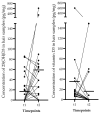Vitamin D Status Assessment: Lack of Correlation between Serum and Hair 25-Hydroxycholecalciferol Levels in Healthy Young Adults
- PMID: 35626384
- PMCID: PMC9140052
- DOI: 10.3390/diagnostics12051229
Vitamin D Status Assessment: Lack of Correlation between Serum and Hair 25-Hydroxycholecalciferol Levels in Healthy Young Adults
Abstract
Vitamin D deficiency has been linked to numerous health problems, including those resulting from disturbed calcium-phosphorus homeostasis, and neuropsychiatric and autoimmune disorders. Nearly one-third of the global population has suboptimal levels of vitamin D, according to epidemiological data. Vitamin D status is usually determined by measuring serum 25(OH)D, but, for decades, serum 25(OH)D measurement has been hampered by a lack of standardization. There have been many recent initiatives to develop reference substances and methods for measuring vitamin D and its metabolites, and re-evaluating the optimal values. It was also suggested that alternative biological samples could also be used, such as hair, since it has been established that lipophilic substances, such as corticosteroids, can also be found in hair. The purpose of this study was to determine the correlation between 25(OH)D3 concentrations in serum and hair, and other demographic features in 26 healthy Caucasian young adult volunteers. The determination of 25(OH)D3 and cholecalciferol was carried out using liquid chromatography coupled with mass spectrometry (LC-MS) from blood and hair samples taken at two timepoints separated by nine weeks. In the hair samples of 18 out of 26 subjects, 25(OH)D was detected at a mean (±SEM) concentration of 17.07 ± 5.375 pg/mg at the first sampling time, and 58.90 ± 25.97 pg/mg at the second sampling time. A multiple linear regression analysis revealed no effects of gender, body mass index, supplementation, or sun exposure on hair 25(OH)D3 concentrations, but supplementation and sun exposure significantly increased serum 25(OH)D3 concentrations. In addition, serum and hair 25(OH)D3 concentrations did not correlate; however, there was a strong correlation between the two sampling times for serum 25(OH)D3 concentrations. In conclusion, this study confirmed that 25(OH)D3 could be detected in human hair, but its use as a biomarker warrants further investigations since no link was found between serum 25(OH)D3 concentrations, supplementation, sun exposure, and hair 25(OH)D3 concentrations levels.
Keywords: 25-hydroxy-vitamin D3; calcidiol; hair concentration; serum concentration; vitamin D status assessment; vitamin D3.
Conflict of interest statement
The authors declare no conflict of interest.
Figures



Similar articles
-
Segmental analysis of human hair reveals intra-annual variation in 25(OH)D3 concentrations in modern and archaeological individuals.Sci Rep. 2025 Jan 24;15(1):3078. doi: 10.1038/s41598-025-86097-6. Sci Rep. 2025. PMID: 39856076 Free PMC article.
-
Serum concentrations of 1,25-dihydroxyvitamin D2 and 1,25-dihydroxyvitamin D3 in response to vitamin D2 and vitamin D3 supplementation.J Clin Endocrinol Metab. 2013 Mar;98(3):973-9. doi: 10.1210/jc.2012-2114. Epub 2013 Feb 5. J Clin Endocrinol Metab. 2013. PMID: 23386645 Free PMC article. Clinical Trial.
-
Oral vitamin D supplementation at five times the recommended allowance marginally affects serum 25-hydroxyvitamin D concentrations in dogs.J Nutr Sci. 2016 Jul 29;5:e31. doi: 10.1017/jns.2016.23. eCollection 2016. J Nutr Sci. 2016. PMID: 27547394 Free PMC article.
-
1alpha(OH)D3 One-alpha-hydroxy-cholecalciferol--an active vitamin D analog. Clinical studies on prophylaxis and treatment of secondary hyperparathyroidism in uremic patients on chronic dialysis.Dan Med Bull. 2008 Nov;55(4):186-210. Dan Med Bull. 2008. PMID: 19232159 Review.
-
Effects of vitamin D3 supplementation on serum 25(OH)D concentration and strength in athletes: a systematic review and meta-analysis of randomized controlled trials.J Int Soc Sports Nutr. 2019 Nov 26;16(1):55. doi: 10.1186/s12970-019-0323-6. J Int Soc Sports Nutr. 2019. PMID: 31771586 Free PMC article.
Cited by
-
Cholecalciferol Supplementation Impacts Behavior and Hippocampal Neuroglial Reorganization in Vitamin D-Deficient Rats.Nutrients. 2024 Jul 19;16(14):2326. doi: 10.3390/nu16142326. Nutrients. 2024. PMID: 39064769 Free PMC article.
-
Segmental analysis of human hair reveals intra-annual variation in 25(OH)D3 concentrations in modern and archaeological individuals.Sci Rep. 2025 Jan 24;15(1):3078. doi: 10.1038/s41598-025-86097-6. Sci Rep. 2025. PMID: 39856076 Free PMC article.
-
Assessment of Vitamin D Status in Great Apes in Human Care.Zoo Biol. 2025 Jul-Aug;44(4):304-312. doi: 10.1002/zoo.21908. Epub 2025 Jun 10. Zoo Biol. 2025. PMID: 40492675 Free PMC article. Review.
-
Vitamin D status among residents of Molidawa Daur Autonomous Banner, Inner Mongolia, North China.Saudi Med J. 2023 Apr;44(4):413-420. doi: 10.15537/smj.2023.44.4.20220780. Saudi Med J. 2023. PMID: 37062548 Free PMC article.
-
Relationship between Serum 25-Hydroxyvitamin D Levels and Hormonal Status in Infertile Women: A Retrospective Study.Diagnostics (Basel). 2023 Sep 22;13(19):3024. doi: 10.3390/diagnostics13193024. Diagnostics (Basel). 2023. PMID: 37835767 Free PMC article.
References
Grants and funding
LinkOut - more resources
Full Text Sources

